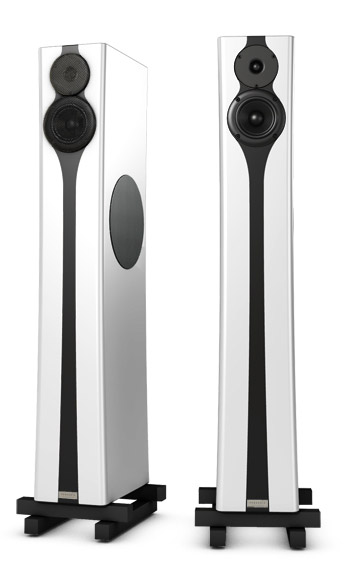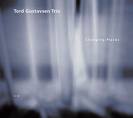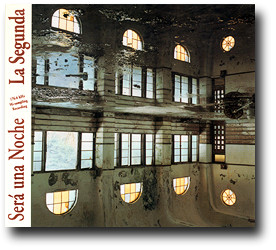Penaudio Chronos
| Penaudio Chronos |
| Yet another good speaker from the land of the thousand lakes? |
|
|
|
September 2007 |
 My first encounter with Penaudio was at the Hifi News Show at Heathrow a couple of years ago. I think they displayed a stand-mounted monitor and subwoofer. I cannot of course describe the sound I heard back then, but I do recall that I liked what I saw and heard.
My first encounter with Penaudio was at the Hifi News Show at Heathrow a couple of years ago. I think they displayed a stand-mounted monitor and subwoofer. I cannot of course describe the sound I heard back then, but I do recall that I liked what I saw and heard.
I am no stranger to Finnish loudspeakers actually. Some years ago I used and enjoyed the Amphion Xenon loudspeakers which are quite similar to the Penaudios, at least as some of the design ideas are concerned. Both are three-ways with side firing woofers. The Amphions are still high on my list of speakers in the sub Euro 5000 range.
But what about the Chronos?
The three-way Penaudio Chronos is the top-of-the-line speaker in their new “Ambient Series.” The tweeter is a 20 mm soft dome, custom made by Seas of Norway. It goes up to 28000Hz where it rolls-off.
The midrange is a Vifa polypropylene coated paper element with a large magnet system. It works in its own reflex loaded cabinet and covers a 120-4400Hz frequency range.
The bass driver is a custom made, side firing aluminum driver from Seas. It is also used in the flagship model, the Serenade. This driver is a long throw 8-incher with a four-layer 39mm voice coil and a cross-over that is made from air core inductors, polypropylene capacitors and oversized resistors. Internal wiring is the Analysis Plus Blue Oval. The cross-over is hand soldered with silver solder, acoustically 4.th order.
The Cabinet is made of 19mm MDF. There is one internal brace in the bass section. Both sections (bass and midrange) are reflex loaded and are damped with two different materials: rubber foam and cotton wool to reduce internal air flow maximally. The cabinet looks very nice and is frankly, quite elegant. The wooden sides and top are made to the highest standards. The binding posts are from WBT.
I heard some vibrations coming from the speakers on several occasions. This may have been the metal grilles moving or something else. The speaker itself seems pretty well constructed although I am not completely sure about the bass chamber. The knuckle test proved that the area around the woofer created a hollow sound when I knocked on the cabinet. When playing loud the cabinet was vibrating rather heavily. It may have affected the sound, maybe not.
I am also not sure what to think about the “foot” on the bottom. Elegant? Maybe, but that is a matter of taste. I know for a fact that this arrangement is not the best way to fix speakers to the floor. You will read more about that later.
Set up
My dedicated listening room is about 5.5 meters long and 4.5 meters wide. The ceiling is 2.3 high. I have a massive wooden floor with a large oriental carpet in front of the system. The walls are made of wood and the only furniture I have is my listening chair, a CD rack and some lower bookshelves.
The room is well treated with acoustic devices from Acoustical Applicata ( DaaD). If you read my review of them you will understand why I couldn’t resist buying some of them. I have never for one day regretted this investment.
I placed the Chronos approximately 1m out from the back wall and approximately 80cm from the side walls. The distance between the loudspeakers was 2.5m with approximately 3m to my listening chair. The side firing woofers were on the inside because it sounded better in my room. At the beginning I let them fire straight ahead, but then I was not satisfied with the soundstage and focus. So, after a couple of days I toed them in so that the inner sides were just visible from my listening chair. And so they remained during the review period.
Some further thoughts about the “foot” at the bottom. I have already told you about my scepticism from the outset of this review. Well, it proved to be right. With no additional tweaks the bass performance I got was less than satisfactory. The bass lacked definition and sounded rather slow. To solve this I put four Finite Elemente Cerapucs under the speakers, they fitted perfectly in the already made holes! That helped a lot. The sound tightened up and the bass got clearly better. I consider that owners of the Chronos must invest in Cerapucs, spikes or whatever. Or even better, Penaudio should include eight spikes in the package. Maybe they do for all I know, but my pair came without them. The speakers were burned in when I got them according to the manufacturer.
The sound in general terms – initial impressions
I am sure that you have read the review of the Serenade on this site. So did I and was full of expectations. In the beginning, I was less than impressed with the Chronos but it somewhat grew on me. This tells me that one has to give new products time to settle into a system. And, difficult as it may be, one has to forget the sound one is accustomed to.
For me, what’s important is “value for the money.” I have, of course, not heard every speaker in this price range, but I know personally what to expect. So let me first give you some general impressions on their sound.
The bass:
Normally it is more difficult to get the bass well integrated with the room when the woofer is mounted on the side, at least in my room. With the Chronos, before I used the Cerapucs, the bass was somewhat muddy, slow and less than well defined. When tweaked the speaker performed considerably better. The midbass was tonally convincing, but a bit on the lean side. This may be the reason that I missed some (but not a whole lot) of the important energy in the music at times. You can read more on that later.
The midrange:
I had no problem hearing what was going on in the music, but voices and instruments lacked some life and energy. Transparency was adequate, not sensational.
The treble:
The highs were extended if not extremely airy and light. But this is a normal dome tweeter so one cannot expect diamond tweeter quality either.
These observations are the ones that I wrote in my notebook after the first week or so. The good thing was that the sound was coherent with no sharp edges or any trace of listening fatigue at all. Even when playing loud over longer periods of time.
Listening – getting to know the Chronos
You know what? The more I listened, the more I liked the Chronos. Or maybe I got accustomed to them is a better way of putting it. From the start of Patricia Barber’s Companion, I was sort of transported to the Green Mill in Chicago, complete with its ambience and audience. But it was a little bit like standing in the bar enjoying that third Gin & Tonic and not getting totally into the music. I believe that the lack of energy in the midbass and a midrange of average (i.e. not bad) quality contributed to this. But I was entertained while listening, even without the Gin & Tonic. We must not forget the fun factor and not get overly critical. When listening at home I do not listen to the treble, midrange or the bass as individual drivers. I listen to the music as a whole. And the Chronos managed just that, the integration of the drivers was seamless on every CD I played.
The bass response was full and extended and I had no problems whatsoever following the bass lines and plucking of M. Arnopol. The Chronos (tweaked with the Cerapucs!) reproduced everything with good definition, right down to their limit. Other speakers may have more impact, but the Chronos was revealing of bottom-end detail.
 Although I love deep, powerful and accurate bass, I prefer midrange clarity and resolution over all. After Barber, I tried another great female singer, Holly Cole and herTemptation [Metro Blue]. This is a superb audiophile recording from the rendering of Cole’s voice to the extremely natural sound. I can play it often without ever tiring of it. It’s a great reference CD both for vocals and instruments, one of the best.
Although I love deep, powerful and accurate bass, I prefer midrange clarity and resolution over all. After Barber, I tried another great female singer, Holly Cole and herTemptation [Metro Blue]. This is a superb audiophile recording from the rendering of Cole’s voice to the extremely natural sound. I can play it often without ever tiring of it. It’s a great reference CD both for vocals and instruments, one of the best.
With the Chronos the sound lacked some colors and excitement, but was all in all pleasant and listenable. Her voice sounded a little laid back where it should be more upfront and some of the percussion wasn’t as detailed and spicy as normal. With the term spicy I mean just that, added flavor like in normal cooking. Percussions often have this effect in music, it all gets more interesting and involving. The Chronos did absorb the spices alright but to that extent that they didn’t come out to serve the music. Instead of hearing the instruments with a certain amount of air between them as it should be, they were more shut in and not clearly separated.
The soundstage was somewhat narrower in depth and height, again compared to my own reference speakers. No, I do not expect the Chronos to match my own Avalon Indra, but it was easy to detect what parts of the listening experience that were missing on a CD that I know very well.
 On Tord Gustavsen Trio Changing Places[ECM], the sound was satisfying. And so it should be, this is one of the best recordings I have heard. This CD is also great to determine the qualities of the midrange/tweeter integration. The piano is very well recorded too. This CD makes you feel his playing physically if your system is up to it.
On Tord Gustavsen Trio Changing Places[ECM], the sound was satisfying. And so it should be, this is one of the best recordings I have heard. This CD is also great to determine the qualities of the midrange/tweeter integration. The piano is very well recorded too. This CD makes you feel his playing physically if your system is up to it.
Then you have (maybe) the most inventive drummer on the Norwegian jazz scene, Jarle Vespestad. This guy uses all of his drum kit; top, the inside and the outside. The only thing he doesn’t use is the backside of the drum-skin. His playing is perfect for a listening test and the evaluation of the upper midrange and tweeter performance. The top end didn’t call attention to itself with a too-showy display of shimmer, but neither was it of ultimate transparency. The cymbals and other percussion sounded like brass, metal and wood by all means, but on my reference speakers the sound of these instruments is transported much longer and deeper into the soundstage. At four times the price of course, but many of these small details contribute greatly to the sound in a high end system.
 Image focus was quite good. Over the last months I have spent many happy nights with Keith Jarrett, Live at the Blue Note (ECM). Seldom have I heard a better recording of a piano trio, this ECM recording is recorded by the Norwegian master Jan Erik Kongshaug. Without boring you with more details about how the Chronos proved themselves with this band I can tell you that it was quite convincing. On a good recording like this one you can, if the system can handle it clearly “see” where the musicians are on the stage. With the Penaudio`s all 3 of them were “visible” right were I am used to. The soundstage though was narrower than what normally is the case; let us call it “more intimate.”
Image focus was quite good. Over the last months I have spent many happy nights with Keith Jarrett, Live at the Blue Note (ECM). Seldom have I heard a better recording of a piano trio, this ECM recording is recorded by the Norwegian master Jan Erik Kongshaug. Without boring you with more details about how the Chronos proved themselves with this band I can tell you that it was quite convincing. On a good recording like this one you can, if the system can handle it clearly “see” where the musicians are on the stage. With the Penaudio`s all 3 of them were “visible” right were I am used to. The soundstage though was narrower than what normally is the case; let us call it “more intimate.”
 The depth in the recording was apparent when the recording allowed, but I didn’t get the feeling that the sound was traveling very far behind the system. The MA Recording La Segunda may be the best recording in my collection. The CD was made in an old church in Argentina using a purist recording technique, like all MA Recording productions.
The depth in the recording was apparent when the recording allowed, but I didn’t get the feeling that the sound was traveling very far behind the system. The MA Recording La Segunda may be the best recording in my collection. The CD was made in an old church in Argentina using a purist recording technique, like all MA Recording productions.
On a great system you can clearly hear and “see” the church walls when you close your eyes. With the Chronos the presentation was convincing, but instead of hearing the musicians where they actually stand in the church it was more difficult to locate them. I guess that this has to do with the level of resolution and transparency the Chronos can offer.
Conclusion
In this price range one can and should expect high class sound. The Chronos didn’t have the last amount of finesse that can take sound reproduction at home to a very high level. The midrange lacked some transparency and the treble was as one can expect, not more. Their bass performance was (to my surprise) their strongest point.
The speaker is basically neutral in that it doesn’t highlight certain parts of the frequency range and is, within its limit quite true to the music.
I heard some vibrations in the cabinet which causes some concern. This could be a fault with the pair I had on test. No need to speculate further on that, but it is my obligation to mention it. The vibration occurred sometimes during loud passages and certainly not on every CD I played.
The Chronos is by no means a bad speaker and I think that they will find many happy owners. But they are in my opinion somewhat too expensive for what they can offer. I must recommend for potential buyers that they also seek out other alternatives in this price range. Penaudio’s own Serenades don’t cost a lot (in relative terms) more and may represent a better deal. That said, maybe the Chronos will suit your tastes and system. Then they may represent money well spent, for you.

________________________
Specifications:
Sensitivity: 87dB/1m/2,83V
Frequency range: +-3dB 34-28000Hz
Nominal impedance: 6 ohms (min. 4, 8)
Cross-over: 120Hz, 4400Hz
Dimensions (WxHxD): 169 x 1030 x 295 cm
Weight: 19kg
Price: EUR 6.000,-
Manufacturer info:
PENAUDIO Ltd.
Nisulankatu 78
FI-40720 JYVÄSKYLÄ
Finland
www.penaudio.fi
sales@penaudio.fi
![]()
Don’t forget to bookmark us! (CTRL-SHFT-D)
Stereo Times Masthead
Publisher/Founder
Clement Perry
Editor
Dave Thomas
Senior Editors
Frank Alles, Mike Girardi, Russell Lichter, Terry London, Moreno Mitchell, Paul Szabady, Bill Wells, Mike Wright, and Stephen Yan,
Current Contributors
David Abramson, Tim Barrall, Dave Allison, Ron Cook, Lewis Dardick, John Hoffman, Dan Secula, Don Shaulis, Greg Simmons, Eric Teh, Greg Voth, Richard Willie, Ed Van Winkle, Rob Dockery, Richard Doron, and Daveed Turek
Site Management Clement Perry
Ad Designer: Martin Perry





Be the first to comment on: Penaudio Chronos